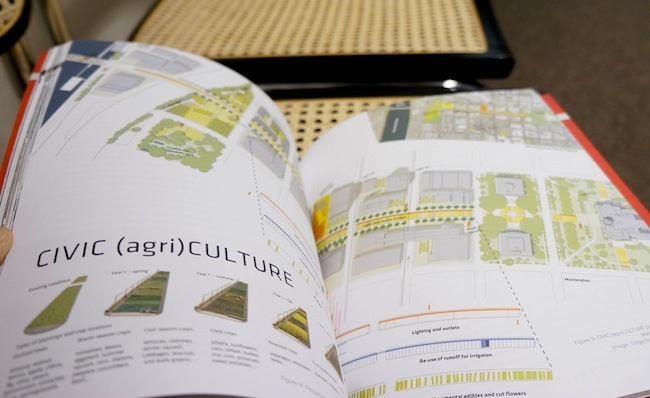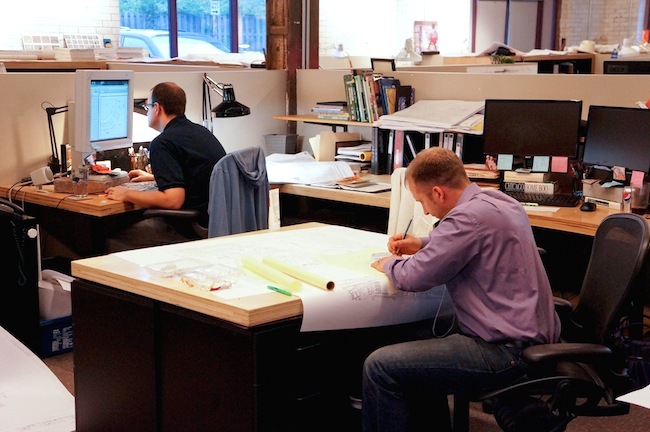Author: Donnie Longenecker
6 Essential Tips for Landscape Architecture Graduates
It’s that time of year again, when landscape architecture students across the world are packing up their trace paper and getting ready to say farewell to the studios that they’ve grown to know so well. It’s finally graduation! And while we wish the Class of 2014 good luck and congratulations during this bittersweet time, we also wanted to give some parting advice as they move on to become working landscape architects. Keep reading to see what words of wisdom Land8 members and professionals Donnie Longenecker RLA, ASLA and John Aikin have to say to this year’s graduates.
 Oslund and Associates’ large library shows the diversity of topics in landscape architecture | © LandscapeVoice
Oslund and Associates’ large library shows the diversity of topics in landscape architecture | © LandscapeVoice
1. Specialize and Find Your Passion in Landscape Architecture
It’s OK to be a jack of all trades, but you may get more notice from your superiors and opportunities for advancement when you become an enthusiastic expert in an important landscape architecture topic.
Donnie: What projects did you LOVE to work on in school? That love equals passion and enthusiasm. If you find firms who work on projects you love, you won’t have to work at getting “psyched up” for the job interview. Worried that your portfolio isn’t good enough for that dream job? Remember this: when all things are equal, attitude trumps talent just about every time.
John: It’s important to be versatile with skill level. As a student, you are armed with an arsenal of skills before graduation. Companies are looking for well-rounded people they can rely on for multiple facets of production in the office. However, focusing on one specific niche of the profession will help you catapult to the top of the stack of resumes in specific offices. Are you a GIS wiz, or a graphics guru? Maybe you’re the plant man or the construction document king. By now you’ve discovered something really fascinating about the profession – hone in on this and allow yourself to become the “expert” in that field.
(RELATED STORY: Filmtastic Fridays – I Want to be a Landscape Architect)
 A peek inside a UC Berkeley student’s work | © LandscapeVoice
A peek inside a UC Berkeley student’s work | © LandscapeVoice
2. Use Graphics to Make Your Resume/Portfolio Stand Out
The Internet is a great resource for this. Check out how Land8’s gallery, Tumblr, and Pinterest collect graphics for inspiration.
Donnie: Take a look at work that’s in Landscape Architecture magazine , blog posts on Land8 and other information sources. Figure out how to make your work look like these projects. That will at least make your portfolio relevant to the current graphic styles.
John: Put yourself in the shoes of a principal or partner in an office during spring and summer. They have a full plate of managing projects, writing proposals, attending meetings, figuring out staffing needs, and trying to find a moment in the day to just sit back and take a breath. Now realize they are receiving upwards of 50 to 200 resumes and portfolios during this time from graduating students looking for jobs and internships. How do you stand out? Most resumes (though not all) are going to be bland and boring like a simple Word Document, and students will rely on their portfolio to give the “wow” factor. However, portfolios and resumes can easily get separated. Stand out by doing something a bit different. If you’re going to use a hard copy resume, try formatting it in landscape instead of portrait and having two columns instead of just one. Use the back to house a few samples that are memorable pieces so no matter where your resume goes, so does your work. And let’s not forget – you can always go back and re-render a past project to make it look more attractive.
(RELATED STORY: How to Transform Basic Sketchup Models into Beautiful Digital Renderings)
 An OSU landscape architecture student works on his online portfolio | © LandscapeVoice
An OSU landscape architecture student works on his online portfolio | © LandscapeVoice
3. Make an Online Portfolio
There are many affordable places to host your portfolio online, from Issuu to Wix to Squarespace to your own hosted website.
Donnie: The reason you get hired is because you are going to help make the firm’s or your boss’ life easier. So I ask, which is easier for your future employer? Receiving a 300 lb, 6300 page portfolio, or having something online which they can review at their convenience?
John: The world of business management is quite different now than it was even 10 years ago. We operate in a world where partners will walk out of the door with nothing more than an iPad and a check set of drawings, when they used to carry briefcases, large computers, rolls of documents, and who knows what else. The time principals and partners spend at their desk seems to be less and less, as they are moving constantly from meetings, offices, work stations, etc. And, quite often their down time to catch up on loose ends is when they are away from their computer. Maybe it’s their train ride to the office, waiting in between meetings, sitting at the airport, taking a quick lunch break. These are great opportunities to click a link and check out a website of work samples from a student who is showing a sense of sustainability, innovation, and creativity by not limiting themselves to a standard static PDF or set of papers. And by the way, make it mobile friendly so they can check it out on their smart phone!
(RELATED GROUP: Portfolios and Resumes – Design Strategies)
 A look inside PWP Landscape Architecture on an informational visit | © LandscapeVoice
A look inside PWP Landscape Architecture on an informational visit | © LandscapeVoice
4. Analyze the Market and Network
Get in contact with and go to events at your local ASLA chapter, always keep an open and positive attitude, and never lose touch with your studio mates!
Donnie: Figure out what you want to do, then go talk to some firms who engage in work you love doing. Use the informational interview to get your foot in the door. Don’t say you want a job interview. Ask them if they have time to review your portfolio , give you a tour of the office, and give you some advice on how to land your “dream job.” That takes all the pressure off everyone. When you’re done, ask if they know anyone else you could talk to. If you do this enough times, you will have built a network of people and also have a good “site analysis” of the firms you want to work in.
John: Again, you are in competition with hundreds of other students who are fighting for the same handful of jobs that you are. We have to try and find ways to stand out amongst the crowd. There’s no better way to do so than to meet those same people who are in charge of hiring you, place a name with a face, and start to develop a relationship. You are immediately giving yourself a leg up over the people who send out 300 PDF’s of their resume and portfolio “To Whom It May Concern” and hope something lands and someone calls them back (which is highly unlikely).
As a personal note, this very approach allowed me to develop some of the closest professional relationships I have to date. Those relationships have proven to be invaluable to me and still open doors to career growth and development several years after college.
(RELATED STORY: Networking Part 1: The Best Kept Secret to Networking)
 Work Life at MKSK’s Columbus Office | © LandscapeVoice
Work Life at MKSK’s Columbus Office | © LandscapeVoice
5. Get an Internship
Experience is key.
Donnie: Hopefully, your college requires you to get an internship. It’s a great introduction into the day to day life of a firm. Regardless, if your only point of entry into the kind of work you love is an internship, take it. All you want and need is the chance to prove yourself. An internship is a great, low pressure way to do just that. It’s better to be inside enjoying the party than pressing your face on the window wishing you could be there.
John: Internships are great for two reasons: You receive that real world experience you really need on your resume in today’s job market, and you have the opportunity to get the bugs out of your system to learn how an office works. It’s extremely difficult for principals to compare a student with a 12 month internship and a student with no actual work experience in a real office, and choose the student with no experience. It would be a crazy risk, and that portfolio and interview would have to be simply outstanding. Not to say it doesn’t happen, because it definitely does. However, it’s a difficult task to achieve. Get an internship and save yourself the hassle.
You also get the opportunity to mess up. As strange as that sounds, it’s a part of the learning process in the profession. There are always mistakes interns make, and it’s quite expected. Some are stupid mistakes, some are just ignorance, some are learning along the way – regardless you learn lessons and work the kinks out so when you are ready for that real job, there’s not a long training period. For example, on my internship I deleted the entire project folder the office was working out of by accident while sorting files. I also chose the wrong printer out of the large number of options available and printed a 75 sheet Word document on full size 30×42 sheets of paper. I turned bright red and freaked out momentarily, but hey, I was an intern. Imagine making those mistakes as a full time employee. The partner I was working with just laughed and shook his head. If I was an employee, I think it might have been a different story.
(RELATED STORY: 7 Top Firms Hiring Landscape Architecture Interns for Summer 2014)
 6. Don’t Give Up and Keep a Positive Attitude
6. Don’t Give Up and Keep a Positive Attitude
Most employers will be more willing to choose an interviewee with okay AutoCAD skills and a stellar attitude/reputation over an interviewee with a poor attitude but great AutoCAD knowledge. There’s always time to improve your skills, but personality is harder to change.
Donnie: Last time the economy was like this, I had to interview/contact 70 different people before I found a job. Looking back, it was a trail that I had to follow in order to get to my destination. So don’t give up. Be polite and persistent. I sent all 70 people a handwritten thank you note. When I finally found a promising opportunity, I called my future boss back every two weeks to check in. After I got the job, he told me the thank you note and my follow up calls moved me ahead of everyone else they were interviewing.
John: When I graduated college, I applied to countless firms over the course of 3 months. I visited the ones I could make the drive to. I called the ones that I couldn’t. It’s a frustrating process, but it’s such an opportunity. Don’t let the process turn into a sounding board for just throwing your resume and portfolio up in the air and hoping someone catches it and calls you back, because it’s not going to happen. Look at all of your reaching out as a legitimate way to make a new contact in the industry. I had numerous people I spoke with give a response of “Hey, I appreciate your efforts and I like your work. We aren’t currently hiring, but let’s stay in touch.” And I did. Don’t let those opportunities go. Maybe your 2nd or 3rd job a few years down the road will come from someone you met with and developed a relationship with over time from your first run of resume sending. You never know.
Congratulations Class of 2014!
Donnie Longenecker RLA, ASLA is an Entrepreneur , Educator and Landscape Architect. He serves as lecturer and continuing education coordinator for the University of Georgia College of Environment and Design. His consulting firm, DTC Inc, provides planning, program and project management services for a wide variety of development projects.
John Aikin, ASLA is a partner with Aikin Design in Richmond, Indiana. He works with a number of landscape architecture and planning firms around the country to develop 3D models, animations, and graphic standards for 3D rendering. John works with firms to train teams of staff in efficient work flow and faster production while incorporating the use of new technology in 3D modeling. He is also a partner with Web Canopy Studio, which is a website development and inbound marketing firm specializing in landscape architecture and architecture website design.
Lead image via Shutterstock



